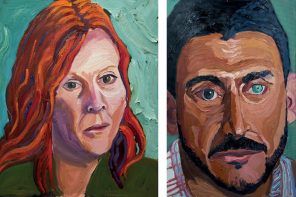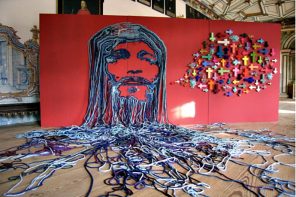I. The teahouse transposed
The word chaikhana, teahouse, evokes for me the memory of Chaikhane Rahat on Rudaki Street in Dushanbe, Tajikistan. It was more a restaurant, filled with the smell of grilling meats and the soft sound of Central Asian music being piped in through the tiny sound system. It did have a very informal feel to it.
That informality is what the Chaikhana of the Muslim Voices Festival was trying to recreate, and they did so successfully. A teahouse should bring to mind a relaxed atmosphere, a place where people sit on the floor, on chairs, on overstuffed cushions. They get up to get tea — in this case Earl Grey, mint tea (meaning to tea with mint, not the herbal stuff), or green tea — and some snacks. If you are near the performance space, you sit quietly and listen, giving your approval of the performers.
Rachel Cooper of the Asia Society introduced the event, highlighting the idea of recreating an intimate space that exemplifies how most Muslims interact with their musicians and poets. The event was a nice counter-point to the staged performances earlier in the week. As a way to break down barriers, it was a brilliant move, where people mingled, sat on floors, and ate food together.
The event also emphasized that while there is some commonality of culture throughout the Muslim world, there is also a great deal of variety.
The evening began with a performance by three West African musicians, from Mali and Guinea, who performed on a modified guitar (not quite a kora), a balafon, and a djembe, played by the singer/guitarist’s young son. The strong familial component of the griot tradition was emphasized.
The pieces were clearly well-rehearsed, but there was a strong undercurrent of spontaneity, which in the intimate setting of the chaikhana made the atmosphere more joyous. It was an incredibly humanizing effect, and the familial presence made that connection even more palpable. The performers did three songs, one called “Peace,” a panegyric for a cultural hero, and a final piece with a chorus in English, French, and an unidentified West African language. None of these songs were overtly religious, but were clearly important for the Muslim community.
The second performer was an Arab poet and reader, who recited three poems. The first was his own poem, about love. The second was a about a boy and a girl of two different, unnamed religions who live in peace in a village in Lebanon until the civil war, when the village is torn apart, but their love remains constant. The final poem was entitled “I would hide you in a flower [my love], but I’m afraid the bees will find you.” All three dealt with a secular love, and with two of the three authors present, there was no ambiguity with respect to authorial intent: it’s about boys and girls, not Muslims and God.
Finally, the third set of performers were from the Urdu poetic tradition, evoking a mehfil or mushaira . The three poets, and “moderator,” conversed with one another and with the audience quite freely. The poems were sung and recited, both without music. The Urdu poetic tradition is conventionally tied to dual readings of the text, both a heavenly and worldly love. The authors/reciters were coy about their intent, but the religious aspect was never emphasized.
The lack of religion in a session about Muslim voices was a nice antidote to the diagnosis that Muslims are too religious. Religion and culture are intimately intertwined, but just as you can talk about religion without referencing culture, so too can you discuss culture without referencing religion. The people on stage were musicians, poets, and readers who just happen to be Muslim. Perhaps their religion influences their art, but their art was not devotional.
On a final note, the “convener” of the Urdu poets, Asad ur Rahman, gave wonderful running commentary on the Urdu poetic tradition and culture. At one point, he made the implicit parallel between the role of the chaikhana in the Islamicate world and the coffee house in early modern Germany as the formative space for the public sphere.
II. Shakespeare in an Arab setting
Shakespeare’s play, Richard III, is retold in a modern Arab setting, and it works disturbingly well. The opening begins with a woman, presumably Margaret, speaking of loss and defeat in Arabic. Without any context, one can imagine her as a Palestinian woman speaking of the Nakba. She speaks of revenge, and how history changes names. One is truly at a loss, until Richard appears, dressed in a formal military uniform. At this point, a heavily abridged Richard III resumes its recognizable course. In this vision, generals with PowerPoint can lead nations to war, and semtex is a useful tool to help change people’s minds. Although the characters are clearly types, they are not stereotypical.
Richard is the secularist, realpolitik, military man who wishes to run the state. Clarence is affiliated with a cohort called the Moderate Islamic Group; Buckingham is a foreign agent, referred to as “Frenchie,” but in league with the American Embassy. Catesby turns from bumbling fool to suffering conscience quite convincingly.
The actors made full use of the space, entering from various areas in the theater and walking past audience members, integrating us into the machinations of the various factions. The setting was some unnamed Arab country, with everyone clearly Muslim. Phrases like “insha’Allah,” “God willing” were bandied about, as were Qur’anic phrases. Although not explicitly mentioned on the super-titles, these quotations were visibly different. In addition, there was Qur’anic recitation during Lancaster’s funeral scene. In perhaps one of the more striking moments of the production, Clarence is performing wudu, the ritual cleansing before prayer, and his assassin drowns him the wudu water. Islam is a recognized part of these characters lives, and the most religious man is made out to be one of the more noble characters. However, this move did not seem to be a valorization of religion, but a complicating of a narrative that religious Muslims are inherently the enemy.
Sulayman Al-Bassam‘s vision is highly nuanced and textured, showing everyone’s foibles. The problems of modern Arab royal families are showcased paralleling the intrigues of Medieval European court life. Richard, the military general, evokes Nasser, Sadat, and especially Saddam Hussein when he finds “religion” later in life. Buckingham is the colonial power, English/American/French, who is interested in putting in a pliant stooge in order to get access to oil. Rather blaming neo-colonialism, religion, or some other external factor for the problems in this fictional Arab country, Al-Bassam spreads the blame. It is the fault of royals who are only interested in themselves; it is the fault of “reformers,” secular and religious, who are only interested in themselves; it is the fault of Western powers who are only interested in themselves. The self-interested actors are not operating in a vacuum, but are feeding off one another. Buckingham introduces Richard to religion to help him gain the support of the people, 99.9% of whom vote him — a dig at the voting records in “democratic” Arab countries. Richard, in turn, asks Buckingham to declare a “War on Terror” to help justify his coup. Of course, Richard eventually denies Buckingham his oil fields, and US military intervention is not far behind. The declaration of war is visually loaded, as three women come out in US military uniforms, twirling white parasols in a pin-up girl style act. On the umbrella are written the three letters in Arab for war, “h-r-b.” The people’s revolt against the military incursion is labelled a “jihad” by Richard, who is equally threatened by the people. Finally, when the names of the ghosts are recited at the end of Richard’s time in battle, they are the names of political prisoners in the Arab world.
The super-titling was excellent, but one thing that did stand out was the wide variety of Arab accents that the actors had. Each region in the Arab world has a distinct accent, and in some cases, the accent is fairly country specific. At first, I thought it was simply what actors were best-suited for each part. However, Anastasia Tsioulcas mentioned that perhaps the diversity was to indicate that this a problem in the Arab world, not just one country. I prefer this interpretation because I think it fits better with quality of Al-Bassam’s vision.
I believe this particular version of Richard III highlights one of the goals of the Muslim Voices Festival: cultures are stronger when in contact with one another. You’ll often hear Muslim say that “Romeo and Juliet” came from the “Layla and Majnun” epic, or “Robinson Crusoe” from “Hayy ibn Yaqzan,” or “Inferno,” from a miraj-namah. While these may be true in a technical sense of antecedents, it misses the larger picture of how we take and adapt from others. It also misses the point of how Muslims have taken and adapted from other cultures. What makes Al-Bassam’s art so instructive on cultural sharing is how well it is done.




